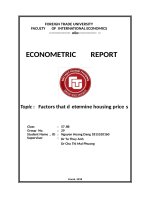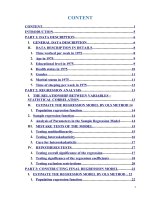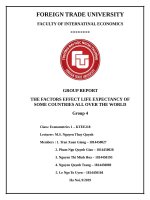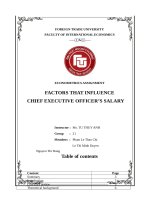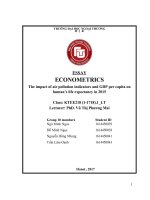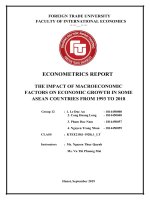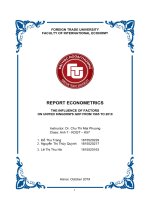tiểu luận kinh tế lượng FACTORS AFFECTING HUMAN’S LIFE EXPECTANCY
Bạn đang xem bản rút gọn của tài liệu. Xem và tải ngay bản đầy đủ của tài liệu tại đây (1.06 MB, 47 trang )
FOREIGN TRADE UNIVERSITY
FACULTY OF INTERNATIONAL ECONOMICS
-----
-----
GROUP REPORT
FACTORS AFFECTING HUMAN’S
LIFE EXPECTANCY
GROUP 2
Group’s members
Student ID
Nguyễn Thu Trang
1814450068
Nguyễn Thị Diệu Ly
1814450052
Lường Thục Uyên
1810450007
Nữ Hoài Linh
1311140052
Class: KTEE218 (1-1920).1_LT
Course: Econometrics 1
Lecturer: MSc. Quynh Thuy Nguyen
Hanoi, September 2019
1
INDEX
ABSTRACT
INTRODUCTION
4
5
SECTION I: OVERVIEW OF THE TOPIC
7
1. Life expectancy
7
2. Component
9
3. Characteristics
10
4. Role to the economy
10
5. Theoretical framework
11
5.1. GDP
11
5.2. Pollution
12
5.3. GNI per capita PPP
15
6. Related research
16
6.1. Samuel H. Preston
16
6.2. Erdal Demirhan, Mahmut Masca (2008)
17
6.3. Rodolphe Desbordes, Céline Azémar (2008)
18
7. Research question:
19
SECTION II: MODEL SPECIFICATION
20
1. Methodology of the study
20
1.1.
Method used to collect secondary data
20
1.2.
Method used to analyze the data
20
2. Theoretical model specification
20
2.1. Describe the data
22
1. Estimate model
1.1.
25
Sample regression model
25
2. Hypothesis Testing
27
2.1.
Hypothesis testing for coefficient of regression
27
2.2.
Hypothesis testing for validation of model
28
3. Solution and Recommendation
29
3.1.
Open to trade and investment, enhance infrustructure
29
3.2.
Promote Human capital and Physical capital
30
3.3.
Air pollution enhancement strategy/orientation
30
2
3.4. More suggestions on raising GDP and GNI
31
CONCLUSION
34
APPENDIX
35
INDIVIDUALS ASSESSMENT
47
3
ABSTRACT
In the context of fast paced globalization and industrialization, human’s life
expectancy is heavily affected by different factors. Some which should be noted are:
GDP per capita, GNI per capita, and air pollution. In order to gain a better
understanding of the three factors’ influence of human expectancy, the team has
gathered data from 180 countries around the world in 2017 and estimated the
regression model using the OLS method. Life expectancy is the dependent variable
with GDP per capita, GNI per capita, and air pollution as the 3 main determinants.
The results showed that both GDP per capita and GNI per capita have positive
relation with life expectancy, with the rise in GDP per capita and GNI per capita
influence an increase in life’s predicted duration. On the the other hand, air
pollution has a negative impact on average longevity.
4
INTRODUCTION
In front of the rapid development of the world regrading both globalization
and industrialization , life expectancy has been increasingly of importance in
measuring national development. Researches have shown the relation between
serveral factors and human longevity. Among them, GDP per capita, GNI per capita,
and air pollution have shown to have notable impact.
A byproduct of industrialisation is environmental pollution. The most
prominent is air pollution, which has adverse influence on human’s well being.
Recently, the air pollution index has experienced a drastic rise. Consequently, the
number of patients with diseases of the respiratory system increases and life
longevity changes. The phenomenon reveals the strong connection between air
pollution and life expectancy.
Moreover, expectation of life is also dependent on the fluctuation of GDP per
capita. Healthcare is essential to everyone; however, the level of medical technology
is different from country to country; more often than not those with better
technology are on the wealthy side. Therefore, a nation’s prosperity can be a
significant factor in measuring life’s duration, making the relationship between
GPD per capita and mortal expectancy worth looking into.
Lastly, in the fast paced development of globalization, it is worth taking into
consideration the impact of GNI per capita has on life’s duration. In spite of
gorvenment’s effort in providing national healthcare system, the task proves to be at
best challenging, and at worst, impossible. Therefore, different individuals possess
different capacities to afford healthcare based on personal income. This creates
different mortality rate in different social classes. It is clear that GDP per capita
plays a vital part in measuring human’s life expectancy.
With a view to giving a better understanding, scruntinizing a specific case, then
looking for appropriate solutions, we would like to tackle the topic “ Factors
affecting human’s life expectancy in 2017”. This report will evaluate the influence
of GDP per capita, air pollution levels, and GNI per capita of 179 random nations
around the world on life’s expectancy. Based on the evaluation, we will suggest
fitting measures to make progress in practicing health care tasks.
5
This essay includes the following content:
I.
Abstract
II.
Introduction
III.
Section I: overview of the topic
IV. Section II: model specification
V.
Section III: estimated model and statistical inferences:
VI.Conclusion:
VII. Appendix:
VIII. References:
IX.Individual assessment:
6
SECTION I: OVERVIEW OF THE TOPIC
Before getting into the affecting factors themselves, it is essential to
understand the meaning of Human life expectancy as well as Human development
index (HDI) and the suitable method of calculating this proxy of human life
expectancy for the social condition of Vietnam and other countries.
1. Life expectancy
* Definition
Life expectancy is a statistical measure of the average time an organism is
expected to live, based on the year of their birth, their current age and other
demographic factors including sex.
Classification – The difference and linkage between Lifespan, Life Expectancy and
HDI
While the term “lifespan” refers to the maximum number of years an
individual can live, life expectancy refers to an estimate or an average number of
years a person can expect to live. Most simply put, life expectancy can be attributed
to and impacted by an individual and their personal health history, genetics, and
lifestyle, whereas lifespan holds for all living humans.
HDI is the statistics of life expectancy, education, and income per capita
indicators. It was developed by the Pakistani economist Mahbub ul Haq and first
published by the United Nations Development Programme (UNDP) in 1990. A
country’s HDI is supposedly higher when there are longer life expectancy, longer
education period and higher income per capita.
* Measure
Over 25 years, there has been 2 main methods to calculate Human life
expectancy proposed by the UNDP. The most commonly used measure of life
expectancy is at birth (LEB), which can be defined in two ways:
- Cohort LEB is the mean length of life of an actual birth cohort (all individuals
born a given year) and can be computed only for cohorts born many decades ago, so
that all their members have died.
7
- Period LEB is the mean length of life of a hypothetical cohort assumed to be
exposed, from birth through death, to the mortality rates observed at a given year.
* Situation
Life expectancy at birth reflects the overall mortality level of a population. It
summarizes the mortality pattern that prevails across all age groups in a given year–
children and adolescents, adults and the elderly. Global life expectancy at birth in
2015 was 71.4 years (73.8 years for females and 69.1 years for males), ranging from
60.0 years in the WHO African Region to 76.8 years in the WHO European Region,
giving a ratio of 1.3 between the two regions. Women live longer than men all
around the world. The gap in life expectancy between the sexes was 4.5 years in
1990 and had remained almost the same by 2015.
Global average life expectancy increased by 5 years between 2000 and 2015,
the fastest increase since the 1960s. Those gains reverse declines during the 1990s,
when life expectancy fell in Africa because of the AIDS epidemic, and in Eastern
Europe following the collapse of the Soviet Union. The 2000-2015 increase was
greatest in the WHO African Region, where life expectancy increased by 9.4 years
to 60 years, driven mainly by improvements in child survival, and expanded access
to antiretrovirals for treatment of HIV.
8
2. Component
Life expectancy is affected by many factors such as:
- Socioeconomic status, including employment, income, education and economic
wellbeing;
- The quality of the health system and the ability of people to access it
- Health behaviours such as tobacco and excessive alcohol consumption, poor
nutrition and lack of exercise;
- Social factors; genetic factors; and environmental factors including overcrowded
housing, lack of clean drinking water and adequate sanitation.
This thesis narrows down the factors into the following 3 significants: GDP, GNI
and Air Pollutions.
Respectively were the three components of the human life expectancy: GDP,
Air Pollution and Per capital income. Argument for these selections was recent
years’ accumulating evidence: Rising incomes and personal well-being are linked in
the opposite way. It seems that economic growth actually kills people.
In a 2000 paper, Christopher Ruhm, an economics professor at the University of
Virginia, showed that when the American economy is on an upswing, people suffer
more medical problems and die faster; when the economy falters, people tend to live
longer. However, after 10 years, in the HDR 2010, a new list of indicators was
presented. Those living in the country's most polluted counties could expect to live up
to one year longer if pollution met the WHO guideline. Globally, the AQLI reveals that
particulate pollution reduces average life expectancy by 1.8 years, making it the
greatest global threat to human health. The counterpart for living standards was Gross
National Income (GNI) per capita instead of Gross Domestic Product (GDP) per capita
to diminish the effect of abroad income, international remittances and/or aid flow.
Overall, the new indicators were much more refined and applicable to the then and
current situation of world as well as national and regional human development,
Vietnam specifically, where globalization is occurring everyday with a tremendous
amount of population working abroad and education has been a focus but actions are
only being effectively carried out in mainly urban areas.
9
All of these components are calculated on the basis of the ratio between real
value minuses minimum value over maximum value minuses minimum value. The
values run on the scale from 0 to 1, with the minimum value being the required value
for a country to merely not go into extinction. Regarding the applicability of the
different approaches on Human life expectancy, it is most accurate and suitable for this
paper to base its output on GDP, Air Pollution and GNI, under the definition from
UNDP HDI 1995 and 2010, of each year calculated by the method applied at the time.
3. Characteristics
Due to its components and calculating methods, LEB holds some important
characteristics, both arithmetically and socially. The LEB index combines the
achievement on various aspects into only one number, which makes it a very broad
proxy, despite not including political participation rate or gender inequality. The
higher the LEB index of a country, the further it is from the point of dying out, the
higher its chance and level of human well-being and development, and vice versa.
By analyzing the Vietnam LEB index over the years, we are able to address the
relative position of our country human life expectancy level comparing to economic
growth level. Moreover, according to the UNDP, LEB can be adapted at country
level as long as there are qualified statistics, and Vietnam is no exception. Finally, a
characteristic of LEB that is in direct relation to our study in this paper is the link
with income and income level, which GDP largely contributes to. As income, in the
form of GDP and later on, GNI, is a part of the LEB, there are supposedly a positive
association among them. Indeed, some countries with very similar GDP or GNI
have entirely different LEB index, implying dissimilarity in human development
level and rate, and in turn, in government policy.
4. Role to the economy
Human life expectancy plays a significant role to one country economy
scenario. With LEB, we are offered an alternative to measure well-being besides and
beyond wealth, which are more easily estimated by income. From LEB indicators, the
core issues of a country such as healthcare, education and living standard are
10
raised and conveniently compared between countries, providing great insights to the
reasons, effects and consequences of government policy. A developing country like
Vietnam can utilize the results and use it as guidance for the authority on the path of
making suitable policy to assist social well-being improvement as a whole.
5. Theoretical framework
5.1. GDP
* Definition of GDP and GDP per capita
GDP is the monetary or market value of the goods and services produced
within the geographic boundaries of a country during a specified period of time,
normally a year.
GDP per capita is a measure of a country's economic output that accounts for its
national population. It divides the country's GDP by its total population.
* Components:
GDP comprises of 4 factors :personal consumption ( C) , business investment
(I) , government spending (G) , and net exports (NX).
Its formula is Y = C + I + G + NX.
*The effects of GDP on life expectancy
(source: />11
The graph shows that life expectancy increases in accordance with the national
GDP per capita, however this is not the case for many countries. For example, Cuba
had the life expectancy of 80 years with a GDP of approximately 9,500$, while the
expectancy of China was only 76 years with a GDP much higher than 10000$.
This could be contributed to the consumption of both needs and wants of
people. They consume needs to survive. Once their needs are satisfied, they will
spend the rest of their life on luxuries and other wants. This makes the increase of
GDP uninfluential to the life expectancy.
Different mortality gaps between social classes can also be a reason. If the
gaps are too wide, it will not matter if the GDP is high, national life expectancy can
still be low due to high mortality rates of the lower class.
Finally, the GDP per capita does not reflect non-market economic activity.
For example, if there is a lot of subsistence farming, people could be working and
have enough food to eat, but wouldn’t be contributing much to the nation’s GDP
because they wouldn’t be buying the food they eat, or selling the food they grow i.e.
no exchange of money. It also does not reflect the income received from foreign
market, therefore the data could be different across countries.
The correlation between GDP per capita and life expectancy can be illustrated by
the Preston curve.
5.2. Pollution
* Definition of pollution
Pollution, also called environmental pollution, is the addition of any
substance (solid, liquid, or gas) or any form of energy (such as heat, sound, or
radioactivity) to the environment at a rate faster than it can be dispersed, diluted,
decomposed, recycled, or stored in some harmless form. Pollution can be classified
into different categories based on its cause:
- Pollution caused by solid wastes.
- Pollution caused by liquid wastes.
- Pollution caused by gaseous wastes.
- Pollution caused by wastes without weights.
12
* Definition of air pollution:
Air pollution is pollution caused by gaseous wastes, such as Carbon
monoxide (CO), Sulphur dioxide (SO2), Nitrogen dioxide (NO2), Ozone (O3) and
smog gases. It may cause respiratory diseases in various degrees of severity in
humans, with the highest level is death; it can also adversely impact other living
organism. Due to the different contribution of density of gaseous wastes, air
pollution is often more severe in the urban areas.
* The situation of air pollution
Air pollution is one of the reasons for a number of health conditions like
respiratory infections, heart disease, stroke and lung cancer. In many cases, air
pollution exacerbates pre-existing cardiorespiratory illnesses—individuals suffering
from asthma, for example, are particularly vulnerable. While it is hard to pinpoint
exactly the number premature deaths or diseases caused by air pollution, it is clear
that the detriments brought about by contaminated air is worsening through time.
By 2017, the estimated pollution caused deaths were estimated to be 2,9 millions,
doubled the number in 1990, which was 1,68 millions.
(source: />13
The cause of such phenomenon could be attributed to the rapid economic growth in
developing countries, like China and India, which resulted in the boom of industrial
wastes.
* Effects of air pollution on life expectancy
Research has shown air pollution reduces life expectancy by approximately a
year. Contaminated air has particulate matter (PM) smaller than 2.5 microns. These
fine particles can enter deep into the lungs, and breathing PM2.5 is associated with
increased risk of heart attacks, strokes, respiratory diseases and cancer. PM2.5
pollution comes from power plants, cars and trucks, fires, agriculture and industrial
emissions.
14
Upper panel A: How air pollution shortens human life expectancy around the
world. Lower panel B: Gains in life expectancy that could be reached by meeting
world health organization guidelines for air quality around the world.
(source: />5.3. GNI per capita PPP
* Definition
GNI or Gross National Income is a measurement of a country's income. It
includes all the income earned by a country's residents and businesses, including
any income earned abroad. Income is defined as all employee compensation plus
investment profits. It includes earnings from foreign sources.
15
GNI per capita based on purchasing power parity (PPP). GNI per capita is a
measurement of income divided by the number of people in the country. It compares
the GNI of countries with different population sizes and standards of living. PPP
GNI is converted to international dollars using purchasing power parity rates. An
international dollar has the same purchasing power over GNI as a U.S. dollar has in
the United States. GNI is the sum of value added by all resident producers plus any
product taxes (less subsidies) not included in the valuation of output plus net
receipts of primary income (compensation of employees and property income) from
abroad. It also does not include the shadow or black economy. Data are in current
international dollars based on the 2011 ICP round.
* The effect of GNP per capita, PPP on life expectancy:
As of GDP, the correlation between GNI per capita and life expectancy can
be demonstrated by the Preston Curve, with similarities in overall trends.
However, as the GNI takes into account the money flow from foreign
markets, as well as using the income rather than the output value a market, its
relationship with life expectancy can differ from that of the GDP. It should be noted
that, as the GNI also includes the income from foreign sources, it reveals a more
inclusive picture of the income inequality and other factors that could come to play
in assessing human life expectancy.
The relationship between life expectancy and GNI per capita is strong
enough to be the basis of a regression model. Simple functions that increase at a
decreasing rate include multiplicative (hyperbolas) and logarithmic functions.
6. Related research
6.1. Samuel H. Preston
The most common theory related to the correlation between economic growth
and life expectancy is the study of Samuel H. Preston, in which he introduced the
Preston Curve. The Preston curve indicates that individuals born in richer countries, on
average, can expect to live longer than those born in poor countries. However, the link
between income and life expectancy flattens out. This means that at low levels
16
of per capita income, further increases in income are associated with large gains in
life expectancy, but at high levels of income, increased income has little associated
change in life expectancy. In other words, if the relationship is interpreted as being
causal, then there are diminishing returns to income in terms of life expectancy.
In the article “Economic Growth and Life Expectancy – Do Wealthier Countries
Live Longer?”, author Audre Biciunaite also points out that the income-life expectancy
relationship can be inverted. This is due to the definition of developed countries which
makes assumptions that do not allow objective measurement.
Regarding the effect of air pollution on life expectancy, Joshua S. Apte with
“Ambient PM2.5 Reduces Global and Regional Life Expectancy” has pointed out
the adverse impact of air pollution on health, more specifically the reduction of
survival. The researchers looked at outdoor air pollution from particulate matter
(PM) smaller than 2.5 microns. The data was collected from the Global Burden of
Disease Study to measure PM2.5 air pollution exposure and its consequences in 185
countries. Researchers then quantified the national impact on life expectancy for
each individual country as well as on a global scale.
6.2. Erdal Demirhan, Mahmut Masca (2008)
In the paper “Determinants of foreign direct investment flows to developing
countries: a cross-sectional analysis”, Erdal Demirhan and Mahmut Masca explored
seven determinants of FDI with a cross-country data of 38 developing countries in
the five-year period from 2000 to 2004. One of those determinants that is directly
related to LEB is GDP per capita, the growth rate of which is used in the research as
the proxy for market size.
Prior to building their own model, the authors mentioned the findings from a
few existing studies on the topic. Market size, measured by GDP per capita appears
to be the most robust FDI determinant in econometrics studies (Artige and Nicolini,
2005). The idea is also supported and further explained by Jordaan (2004), who said
that FDI tend to flow into economies with larger and expanding markets, translating
into greater purchasing power or higher GDP per capita, the markets from which
17
firms have a higher chance to earn better returns from invested capital and thus
increase profit, life expectation.
6.3. Rodolphe Desbordes, Céline Azémar (2008)
In research “Public Governance, Health and Foreign Direct Investment in
Sub-Sahara Africa”, the two authors Desbordes and Azémar examined the effect of
human health on GDP by two ways. First, by accounting for the Foreign
development index (FDI) deficit in Sub-Sahara Africa regions, they found out that
due to low human accumulation, especially health, 110-140% of FDI gap between
SSA’s regions was explained. Second, they also developed a relationship between
infectious diseases on the reduction of GDP. The result was that 1% increase in HIV
prevalence in the adult population is responsible for the decrease of GDP due to
3.5% down in net FDI inflow.
After comparing percentage change in GDP and FDI between different
regions and continentals in the world, they saw that FDI inflow in median countries
in SSA was less than 1% of their GDP, thus claiming that poor public governance
was responsible for this trend. With the lack in domestic-oriented and externaloriented policies, SSA’s governments could not regulate the economic growth which
then resulted in low GDP and FDI inflow. However, this paper also showed that
SSA’s GDP deficit was mostly explained by market size and insufficient public
goods provisions, especially health care services. Additionally, a remarkable point
that the authors offered was that once HIV and malaria did not exist, the net inflow
of FDI every year in the median SSA country would have been predicted to be onethird higher in the period 2000-2004.
At the end of the research, they explained the results by several reasons. First, as
poor health conditions raised the production labor cost and labor compensation as well
as reduced productivity, it might trigger a drop in staff morale which caused low
productivity. Furthermore, high cost of recruiting and training new skilled workers
would only create more burden to the weak economy. Finally, it is possible that
18
foreign investors, on the purpose of seeking for efficiency or market, tended to
avoid countries in which people died because of infectious and dangerous diseases.
7. Research question:
Accordingly, this research aims to fulfil the objectives in the followings:
First, to determine the deciding factors that affect on human life expectancy
Second, to explain the influence of GDP per capita, GNI per capita, and air
pollution on human life expectancy
Third, based on the above analysis, to propose the combat methods to
the negative impact that air pollution can possibly have on human life
expectancy, while enhancing the advantages in the relationship between
GDP per capita, and GNI per capita with life expectancy
In order to achieve these objectives, the study will answer the following questions:
First: What is human life expectancy and how is it affected, measured on a
general basis?
(Overview, Part 1 – 4)
Second: What are the two-way linkage between human life expectancy and 3
factors: GDP per capita, GNI per capita, and air pollution?
(Theoretical Framework and Public Research)
Third: How effective are estimated models and statistical inferences to the
hypothesis
(Hypothesis Testing)
Fourth: What are the specific recommendation for improving human
life expectancy? (by altering the GDP per capita, GNI per capita, and air
pollution)
(Recommendation)
19
SECTION II: MODEL SPECIFICATION
1. Methodology of the study
1.1.
Method used to collect secondary data
The team collected sample and estimated values based on data from 180
observations in 2015 from 180 countries worldwide. For quantitative results, the
number of outputs should be equal to the number of inputs, which is the data
collected by the statistical method.
1.2.
Method used to analyze the data
By using OLS method, data is selected and checked the statistical significance
of the regression coefficients and the suitability of the model based on the observed
observations comparing with the previous research and similar studies, to find the
best results to use for analysis.
During the course of the project, the team used the knowledge of econometrics
and macroeconomics, quantitative methods with the main support of STATA
software, Microsoft Excel, Microsoft Word for synthesis and completion of this
report.
2. Theoretical model specification
In order to construct an econometric model, it is first necessary to identify the
factors that are involved in the interaction and description of economic variables. In
order to obtain the results of the computation and analysis of the output, the statistical
method used in the two fields is the estimation and verification of the hypothesis.
Thus, in order to analyze the factors influencing the human’s life expectancy,
the group used the regression analysis model to show the trend of variable in terms
of the average of the sample. With the specimen, the regression function is a
function with specific numerical, computational, and differential values such as
derivatives, differential and direct meaning analysis.
20
Base on given theoretical framework as well as previous research, the team did
build this following model to analyze the effect of some factors to Human’s Life
Expectancy.
LE = f(GPC, AP, GIC)
In which:
LE : Life Expectancy at Birth (year)
GPC : Gross domestic product per capita (USD)
AP : Air polution (µg/m3)
GIC: Gross national income per capita (USD)
To determine the influence of 3 given factors on human’s life expectancy, from the
theory presented above, the team proposed the following research model:
Population Regression model:
LEi = β0 + β1.GPCi + β2.APi + β3.GICi + ui
Sample Regression model
̂̂ ̂
̂̂
̂̂
LEi =
Run the command : des LE GPC AP GIC to describe all variables:
+ .+ .+ .+ ̂
. des LE GPC AP GIC
import excel "C:\Users\ndhoang8890\Desktop\STATA\DATA TABLE.xlsx",
sheet("DATA") firstrow
variable
name
storage
type
display value
format
label
variable label
LE
byte
%10.0g
LE
GPC
double
%10.0g
GPC
AP
int
%10.0g
AP
GIC
long
%10.0g
GIC
21
Explain the variables
Variables
Meaning
Unit
LE
Life expectancy
year
GPC
GDP per capita
USD
+
Air pollution PM2.5
µg/m3
(microgram
-
(annual exposure)
per cubic
AP
Value expectation of
regression coefficient
meter)
GIC
GNI per capita
USD
+
In which:
- Dependent variable: LE
- Independent variables: GPC, AP and GIC
2.1. Describe the data
* Data source
Variables
Link
LE
/>
GPC
/>1960
AP
/>
GIC
/>
* Statistical description
The team use the sum statement to describe the data, the “sum” command shows
the number of observations (Obs), the average value (Mean), standard deviation
22
(Std.dev.) as well as the maximum value (Max) and the minimum value (Min) of all
the given variables.
. sum LE GPC AP GIC
Variables
Obs
Mean
Std. Dev
Min
Max
LE
180
71.53333
8.035814
51
84
GPC
180
12804.26
17554.63
303.7
101909.8
AP
180
28.34444
19.77875
3
107
GIC
180
18850.32
20637.23
750
121090
From the result above:
The standard deviation of variable LE is 8.035814, a high standard
deviation, which means the difference in life expectancy across countries
is relatively high. Rich countries, developed countries often have a high
average life expectancy (over 80 years), mainly in the Americas and
Europe, while those in Asia and Africa are developing countries, with the
average longevity of usually around 60 to 70 years.
The standard deviation of variable GPC is 17554.63. This is also a high
standard deviation, which shows that the gap in average income between
various countries worldwide is quite large. It is totally understandable
because there is a marked difference in the level of economic
development among nations. GDP per capita income of the Americas or
Europe is often much higher than that of Asian or African countries.
The mean value of 28.34444 indicates that the level of pollution is mild
(the safe level is 25) and the standard deviation is 19.77875. Countries
with severe levels of pollution are often poor, developing countries in
Asia and Africa (For example: Qatar: 107, Saudi Arabia: 106, India: 74,
Kuwait: 67), whereas in developed countries in Europe and America,
pollution levels are very low (For example: Australia: 6, USA:
8,Denmark: 11, UK: 12, Sweden: 13).
23
Variable GIC has the highest value of standard deviation among 4 given
variables: 20637.23. This result is reasonable because people in high
income countries may enjoy much convinience than people in low income
countries.
Correlation matrix between variables
Before running the regression model, we consider the correlation between
variables by using the “corr” command. We obtained the correlation table between
the variables as follows:
. corr LE GPC AP GIC
LE
GPC
AP
LE
1.0000
GPC
0.6291
1.0000
AP
-0.3224
-0.2420
1.0000
GIC
0.6413
0.8181
-0.0672
GIC
1.0000
From the result above:
GPC has a quite high correlation coefficient is 0.6291 and it has a positive effect
on dependent variable LE.
AP has a medium correlation coefficient is 0.3224 and it has a negative effect on
dependent variable LE.
GIC has a quite high correlation coefficient is 0.6413 and it has a positive effect
on dependent variable LE.
* Conclusion:
From the above analysis, it can be seen that independent variables correlate
with the dependent variable, and between the independent variables also correlate.
The correlation between dependent variable and independent variables, and
between independent variables is exactly as expected.
24
SECTION III: ESTIMATED MODEL AND STATISTICAL INFERENCES:
1. Estimate model
To run the regression model, we execute the “regress” command as follows:
. reg LE GPC AP GIC
Number of
F(2, 177)
Prob > F
R-squared
obs
=
=
=
=
LE
180
58.38
0.0000
0.4988
Coef.
Std.
t
P>|t|
[95%
Err.
Conf.
GPC
.0000805
.0000449
1.79
0.075
AP
-.1005909
.0229857
-4.38
0.000
Interval
]
-8.21e-06 .0001691
-.145954
.0552278
GIC
.0001872
.0000372
5.04
0.000
.0001139 .0002606
_cons
69.82471
.8898684
78.47
0.000
68.06852 71.58089
1.1.
Sample regression model
Having data result after running ‘reg’ command, the team proceed to read and
analyze data.
* Sample Regression model
We have the sample regression equation:
LE=̂+̂ +̂ +̂ +̂ i
25
.
.
.

